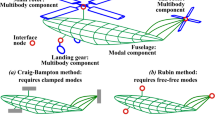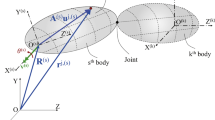Abstract
A method of reducing the system matrices of a planar flexible beam described by an absolute nodal coordinate formulation (ANCF) is presented. In this method, we focus that the bending stiffness matrix expressed by adopting a continuum mechanics approach to the ANCF beam element is constant when the axial strain is not very large. This feature allows to apply the Craig–Bampton method to the equation of motion that is composed of the independent coordinates when the constraint forces are eliminated. Four numerical examples that compare the proposed method and the conventional ANCF are demonstrated to verify the performance and accuracy of the proposed method. From these examples, it is verified that the proposed method can describe the large deformation effects such as dynamic stiffening due to the centrifugal force, as well as the conventional ANCF does. The use of this method also reduces the computing time, while maintaining an acceptable degree of accuracy for the expression characteristics of the conventional ANCF when the modal truncation number is adequately employed. This reduction in CPU time particularly pronounced in the case of a large element number and small modal truncation number; the reduction can be verified not only in the case of small deformation but also in the case of a fair bit large deformation.
Similar content being viewed by others
Abbreviations
- A :
-
cross-sectional area of beam
- B :
-
velocity transformation matrix
- C :
-
constraint equation
- e :
-
nodal coordinate vector
- E :
-
Young’s modulus of beam
- I :
-
second moment of area of beam
- K :
-
stiffness matrix
- l :
-
beam length
- M :
-
mass matrix
- m c :
-
number of constraint equation
- n b :
-
number of degrees of freedom of the boundary region in a component
- n c :
-
number of normal modes
- n e :
-
number of elements in a component
- n i :
-
number of degrees of freedom of interior region in a component with n e elements
- n t :
-
number of truncation modes
- n r :
-
number of degrees of freedom of the reduced component
- q :
-
generalized coordinate vector
- x :
-
local coordinate of element in undeformed configuration
- ρ :
-
density of beam element
- ξ :
-
modal coordinate vector of normal modes
- \(\varOmega _{m}^{2}\) :
-
eigen value of mth normal mode
- subscript b,i :
-
boundary and interior regions of beam element
- subscript dp, in :
-
related to dependent and independent coordinates
- subscript l :
-
related to axial direction of beam element
- subscript m :
-
the mode number
- subscript t :
-
related to bending of beam element
References
Rupp, C.C., Laue, J.H.: Shuttle/tethered satellite system. J. Aeronaut. Sci. 26(1), 1–17 (1978)
Funase, R., Sugita, M., Mori, O., Tsuda, Y., Kawaguchi, J.: Modeling of spinning solar sail by multi particle model and its application to attitude control system. In: Proceedings of Design Engineering Technical Conference, DETC2009-87821, ASME, pp. 1–12 (2009)
Müftü, S.: Mechanics of a thin, tensioned shell, wrapped helically around a turn-bar. J. Fluids Struct. 23(5), 767–785 (2007)
Shabana, A.A.: Flexible multibody dynamics: review of past and recent developments. Multibody Syst. Dyn. 1(2), 189–222 (1997)
Shabana, A.A.: An absolute nodal coordinate formulation for the large rotation and deformation analysis of flexible bodies. Technical report MBS96-1-UIC, University of Illinois at Chicago, pp. 1–26 (1996)
Escalona, J.L., Hussien, H.A., Shabana, A.A.: Application of the absolute nodal coordinate formulation to multibody system dynamics. J. Sound Vib. 214(5), 833–851 (1998)
Shabana, A.A.: Dynamics of Multibody Systems, 3rd edn., pp. 314–343. Cambridge University Press, Cambridge (2005)
Berzeri, M., Shabana, A.A.: Development of simple models for the elastic forces in the absolute nodal co-ordinate formulation. J. Sound Vib. 235(4), 539–565 (2000)
Shabana, A.A., Yakoub, R.Y.: Three dimensional absolute nodal coordinate formulation for beam elements: theory. J. Mech. Des. 123(4), 606–613 (2001)
Mikkola, A.M., Shabana, A.A.: A non-incremental finite element procedure for the analysis of large deformation of plates and shells in mechanical system applications. Multibody Syst. Dyn. 9(3), 283–309 (2003)
Dmitrochenko, O.N., Pogorelov, D.Y.: Generalization of plate finite elements for absolute nodal coordinate formulation. Multibody Syst. Dyn. 10(1), 17–43 (2003)
Dmitrochenko, O.N., Mikkola, A.M.: Two simple triangular plate elements based on the absolute nodal coordinate formulation. J. Comput. Nonlinear Dyn. 3(4), 0410121–0410128 (2008)
Hurty, W.C.: Dynamic analysis of structural systems using component modes. AIAA J. 3(4), 678–685 (1965)
Craig, R.R. Jr., Bampton, M.C.C.: Coupling of substructures for dynamic analyses. AIAA J. 6(7), 1313–1319 (1968)
MacNeal, R.H.: A hybrid method of component mode synthesis. Comput. Struct. 1, 581–601 (1971)
Géradin, M., Cardona, A.: Flexible Multibody Dynamics—A Finite Element Approach, pp. 185–202. Wiley, Chichester (2001)
Gerstmayr, J., Ambrósio, J.A.C.: Component mode synthesis with constant mass and stiffness matrices applied to flexible multibody systems. Int. J. Numer. Methods Eng. 7(11), 1518–1546 (2008)
Iwai, R., Kobayashi, N.: A new flexible multibody beam element based on the absolute nodal coordinate formulation using the global shape function and the analytical mode shape function. Nonlinear Dyn. 34(1–2), 207–232 (2003)
Guyan, R.J.: Reduction of stiffness and mass matrices. AIAA J. 3(2), 380 (1965)
Inman, D.J.: Engineering Vibration, pp. 329–337. Prentice Hall, New York (1994)
Berzeri, M., Shabana, A.A.: Study of the centrifugal stiffening effect using the finite element absolute nodal coordinate formulation. Multibody Syst. Dyn. 7(4), 357–387 (2002)
Author information
Authors and Affiliations
Corresponding author
Rights and permissions
About this article
Cite this article
Kobayashi, N., Wago, T. & Sugawara, Y. Reduction of system matrices of planar beam in ANCF by component mode synthesis method. Multibody Syst Dyn 26, 265–281 (2011). https://doi.org/10.1007/s11044-011-9259-6
Received:
Accepted:
Published:
Issue Date:
DOI: https://doi.org/10.1007/s11044-011-9259-6




